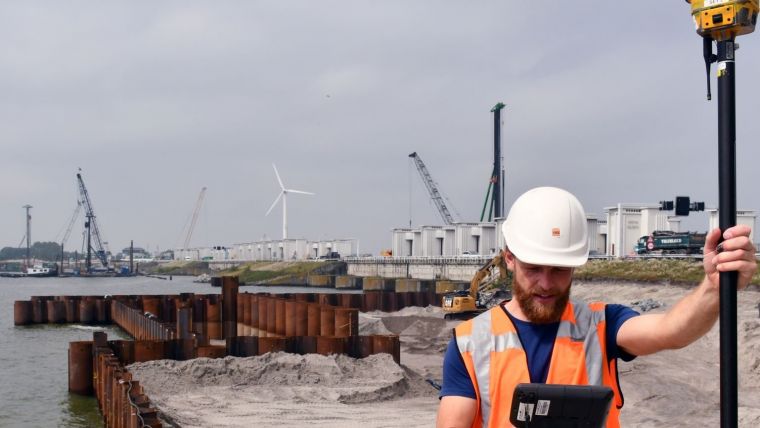Talent, technology, data and climate at the forefront of professionals’ minds
Insights into key trends, developments and challenges in the geospatial sector
In line with tradition, we have conducted the latest annual 'GIM International' survey among our readership of geospatial professionals to identify key trends, developments and challenges related to technology and business operations. This year’s findings highlight the importance of sustainability, education and training, and the adoption of new technology in the geospatial sector. The mood is optimistic, but potentially threatening external factors are lurking in the shadows. Nevertheless, it is clear that technological developments are opening up new horizons for today’s and tomorrow’s mapping and surveying professional.
Kristalina Georgieva, managing director of the International Monetary Fund (IMF), recently shared a widely publicized warning that ‘deglobalization’ – the economic fragmentation of the world – could cause a major blow to the worldwide economy, potentially leading to a global contraction of 7% in the long term. According to Georgieva, economic integration in recent decades has resulted in billions of people becoming wealthier, healthier and better educated. The Bulgarian IMF chief stated: “Since the end of the Cold War, the world economy has roughly tripled and nearly 1.5 billion people have been lifted out of extreme poverty. These gains of peace and cooperation should not be wasted.” In summary, international cooperation is essential to tackle the future challenges; governments should prioritize promoting trade, reducing debt and addressing climate issues, rather than forming blocs and engaging in conflicts. Needless to say, the geospatial sector forms part of – and is affected by – the world economy, so this economic backdrop inevitably provides meaningful context for interpreting the outcomes of our industry survey.

Optimism all around
The responses to our latest survey suggest that the majority of geospatial professionals view the surveying and mapping industry prospects as even better this year than in 2022. 43.6% of the respondents believe that the prospects will be better, 24.2% believe they will be much better and 26.3% believe they will be the same, while less than 6% believe they will be worse or much worse. This indicates a general sense of optimism in the geospatial industry about the coming year, and it is probably somewhat influenced by the growing belief that the COVID-19 era is now behind us.
Of course, we should remember that these responses are subjective. The survey respondents’ opinions may not reflect the industry’s actual future prospects, especially when we consider what economic experts are predicting. Nevertheless, much of the feedback obtained from the mapping and surveying professionals who took the trouble to complete our survey confirms the positive mood. There are several reasons for the seemingly unwavering optimism. Many respondents highlight the increased economic activity and post-COVID developments, with more projects and sites reopening and new opportunities emerging related to the Fourth Industrial Revolution. Meanwhile, increasing attention is being paid to the role of geospatial data in addressing challenges such as climate change. All these developments are driving the need for geomatics expertise.
One geospatial professional from Louisiana, USA, highlights the extensive state and federal infrastructure investment in her country, and the need for land acquisition and construction surveys. Numerous survey participants mentioned public and private investment in renewable energy, new mines and new electricity transmission projects, such as huge new projects for solar farms or undersea power lines. Green hydrogen is also cited as a new opportunity with a promising future.
Overall, the respondents believe that the need for more and better data and modelling is becoming more evident, which clearly has a positive impact on the prospects for the surveying and mapping industry in 2023. This combined with many projects being revived (in line with the post-Covid economic recovery) and new opportunities arising from the 4th Industrial Revolution as well the contribution of geospatial data to challenges such as climate change.
Industry concerns
Despite the overwhelmingly positive outlook, there are still some concerns among geospatial professionals. It is interesting to take a closer look at these concerns to understand the risks that the geospatial industry faces and how they might be tackled. Some of the perceived threats relate to macroeconomic and geopolitical trends, partly in line with the concerns expressed by the IMF. Despite the widespread optimism, some survey respondents regard a financial downturn as a real possibility in 2023. For example, recessions may be looming as various countries are currently experiencing inflation. One of the respondents states: “From a revenue growth perspective, the industry may be impacted by inflationary pressures and also increased competition from new market entrants charging lower prices for products and services.”
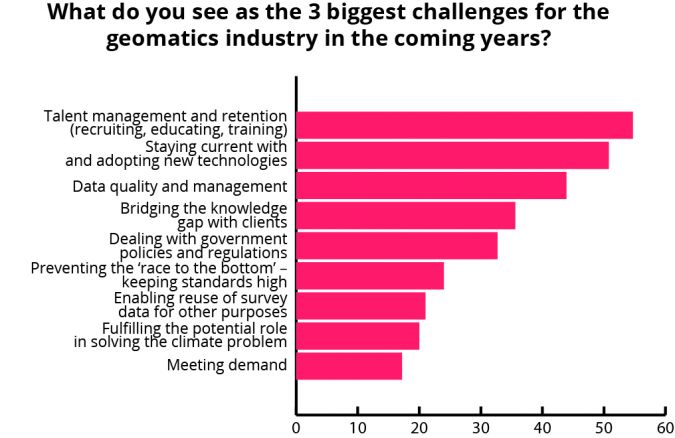
In terms of other factors that could present serious hurdles for the geospatial industry, a staggering number of respondents express their concerns about the future of their profession. One respondent point out that the average age of surveyors in many Western countries is well above 50, adding that even this estimate may be conservative. This implies that a significant number of surveyors will be retiring in the next 15 years. In many European countries, for instance, this is coupled with a rather low number of students that graduate from surveying programmes. One respondent sums this up by stating: “There are not enough surveyors being produced through the system to meet an ever-burgeoning demand for qualified professionals.” Another puts it more bluntly: “Surveying is a dying industry with more surveyors retiring than our coming in”. Meanwhile, another respondent expresses their fears that the scarcity of surveying experts is likely to worsen in the future. As previously reported in GIM International, there is indeed a significant lack of young talent coming to work in the sector, as well as a shortage of skilled employees. In fact, according to our survey, this is one of the three biggest challenges facing the geospatial industry in the coming years, as explained in more detail below.

The three biggest challenges
1. Talent management and retention (recruitment, education, training):
To meet growing demand for geospatial data and insights, the geospatial industry actually faces two major challenges relating to talent management: firstly to attract more people into the sector, and secondly to improve the retention and deployment of existing employees based on reskilling and continuous professional development. So what is at the root of these challenges, and how can they be solved? One of the survey respondents has strong views on this: “As a profession, surveying has lost its way. It is not ‘seen’ as a potential career for second-level students entering third-level studies. It needs to adopt clear messaging: technical geomatics skills and spatial data capture and management competencies are core to sustainable spatial planning, environmental management and decision-making, to achieving the Sustainable Development Goals and to good governance. The geospatial industry needs to communicate the ‘risks’ involved in this lack of appreciation of good data capture, analysis and management.” Many agree that our industry has somewhat of an image problem, since most people outside the industry still don’t know what geodesy is. One thing that we can conclude from the numerous comments is that the sector has some work to do when it comes to talent management. Some of this year’s survey respondents suggest that better training and career opportunities should be on offer to appeal to the younger generation’s higher expectations, while others advocate that the industry should transform itself into a tech-savvy field to offer more exciting and impactful career prospects. One could ask whether we still need an influx of new surveying professionals, in view of all the technological advancements that have revolutionized the sector. The general consensus seems to be that the demand for geospatial professionals will continue to grow as such technologies become more prevalent, as expressed by this response: “Despite all the exciting high-tech solutions in reality capturing, it’s very important to note that they cannot replace the need for more skilled professionals to drive the industry forward.”
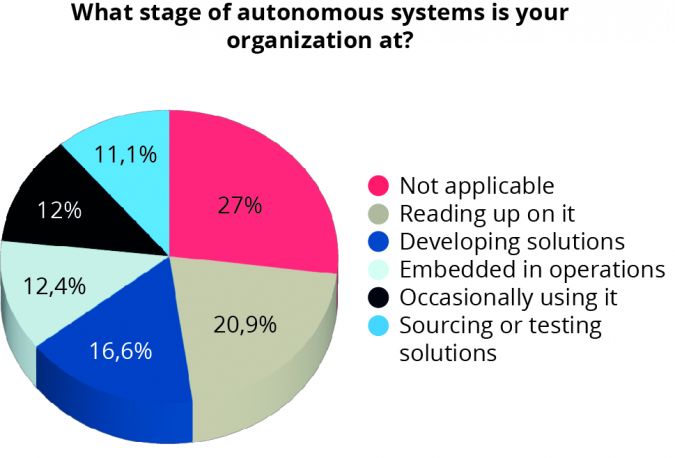
2. Staying up to date with and adopting new technologies: The adoption of advanced technologies into new or existing workflows is becoming increasingly important in order to stay competitive in the market. “This shift is not just about finding and retaining employees, but also about using our data more effectively and efficiently. Implementing knowledge management systems to easily retain and access data, as well as adopting standards for data and information sharing, are key in this process,” states one respondent from Brazil. One area where advanced technologies can greatly benefit is in the processing of Lidar and mapping data for 3D modelling. “The use of AI (artificial intelligence, Ed.) software can greatly reduce the cost of processing and analysis. Drones have also proven to be useful for mapping, but they currently have limitations. As the demand for spatial data continues to rise across various industries, advancements in drone technology will lead to wider-scale adoption in the geospatial industry,” explains a respondent working for a leading spatial information technology provider in India, as one of the numerous comments received on this topic.

3. Data quality and management: Many respondents make reference to the significant technological changes they have observed in the surveying and mapping industry in recent years. The fast-paced technological developments present new challenges. “The big data revolution and knowledge-doubling curve are not relenting,” one of the respondents states. Another respondent shares his thoughts as follows: “It is important to capitalize on the strengths of big data and utilize it where it can add the most value. As new applications for remote sensing and big data continue to emerge, and new sources of remotely sensed data become available, surveyors should embrace the abundance of opportunities provided by these new tools.” This ties in with the ongoing shift of the land surveying profession towards automation and mass data gathering. Mobile mapping, scanning and other technologies are allowing for automatic machine extraction of data with minimal human intervention. While these new technologies have the potential to improve efficiency and accuracy, surveyors also have concerns about cost, complexity, data privacy and, not least, the knowledge of how to handle and use the resulting data. For example, many respondents highlight the importance of understanding how to integrate datasets from a wide variety of reality capture techniques.
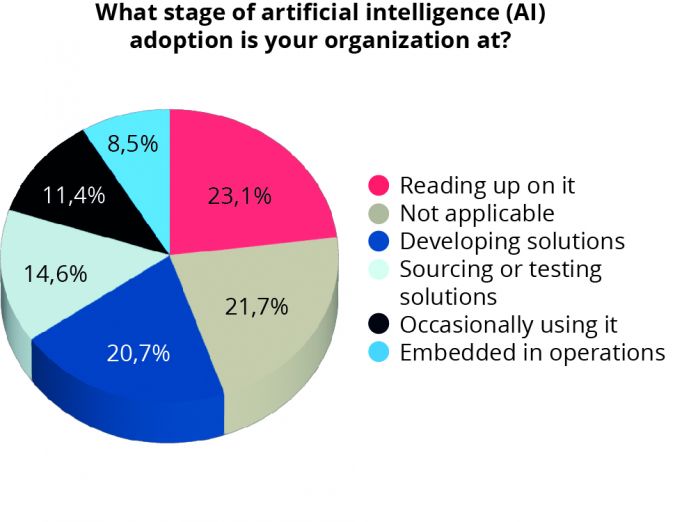
AI, machine learning and digital twins
Machine learning (ML) offers a way to cope with the mind-boggling amount of data generated through automated data acquisition. Indeed, after having been a promising field of technology for decades, we have recently witnessed a significant acceleration in its development and the emergence of major trends that signify a golden age for machine learning, AI and advanced analytics. Industries such as infrastructure and space are already adopting such technologies, but what is the current view in the geospatial profession? “Given our history as a geospatial services provider, it is clear that if we do not embrace AI and ML, we risk becoming obsolete as companies using these technologies will surpass us. We must acknowledge this reality and take action,” states one respondent. The digital twin trend, which is rapidly gaining momentum, is one example of how geospatial professionals are already combining their knowledge and skills with AI and the Internet of Things (IoT). One of the respondents comments: “Most of our work ends up in digital twins and smart cities-type applications, in all sectors. These technologies are the choice of the modern user.” Visualization technologies such as virtual reality (VR) and augmented reality (AR) are increasingly playing an important part in sharing insights with users. Indeed, geospatial data-fed digital twins offer far-reaching possibilities. They enable us to make accurate decisions and take precautions based on advanced simulation models, for example. But as one surveyor with his own engineering consultancy agency reminds us: “The reliability of digital twins is directly dependent on the quality, completeness and timeliness of the data used.” This underlines “the importance of trained geospatial professionals in guiding the correct and ethical use of these technologies.”
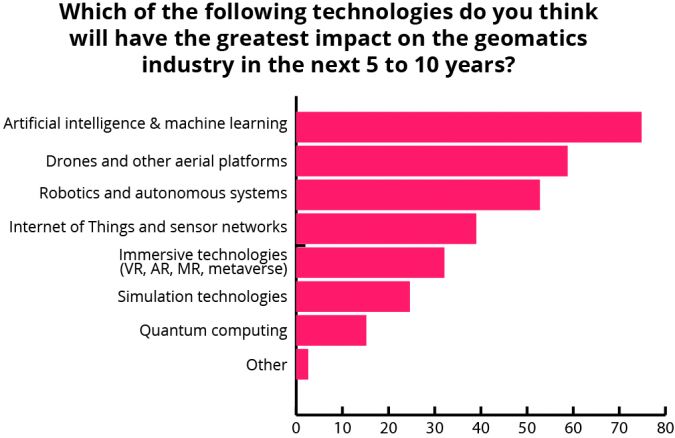
Climate change and sustainability
Last but not least, the striking number of comments we received from survey participants emphasize the importance of the topic of climate change. As one respondent states in a very matter-of-fact manner: “Solving the climate change challenge is not really our task, but our geospatial data can contribute to it.” This year’s industry survey reveals that, besides playing a broad role by facilitating the use of geospatial data to tackle climate-related issues, an increasing number of organizations are putting the environment centre stage within their own operations. For example, one respondent comments: “Our company is focusing more and more on environmental monitoring and tries to increase its dependency on renewable energy sources.” Another survey participant explains: “We are reducing our actual CO2 emissions and helping customers with their own sustainability strategies.” A third response states: “Sustainability for our company is about being proactive on the global warming front and actions are being taken to ensure we are ‘net zero’ by 2050.”
With the right perspective, embracing sustainability not only addresses the threat of climate change but also opens up new business opportunities. A study conducted by IT research and consulting firm Gartner revealed that environmental and social change is now a top-three priority for investors, after earnings and revenue. Executives are realizing that investing in innovative solutions designed to help them achieve sustainability goals can give them a competitive advantage. Survey firms and mapping companies are starting to embrace this idea too, as illustrated by one respondent: “I feel like we are above most of our competitors in the push to sustainable services.” Moreover, the ongoing shift towards a more sustainable way of living is creating new application areas, such as the renewable energy sector and smart city management, all of which require significant volumes of geospatial data, thus further enhancing the prospects for our industry.
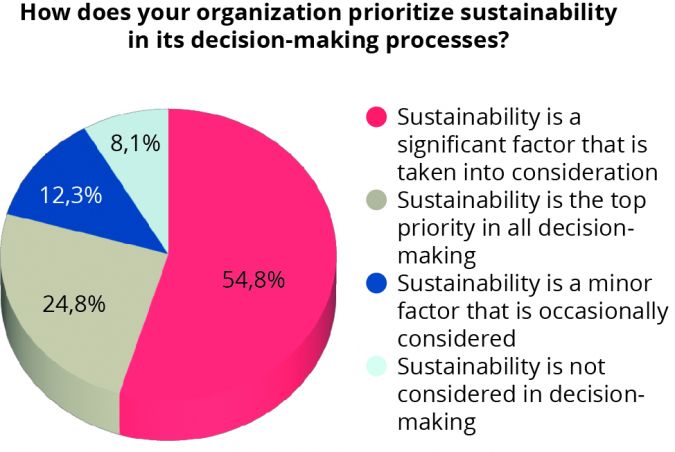
The future of the surveying profession
Our survey reveals overwhelming optimism, tempered only by a few concerns related to the significant changes taking place in the field of surveying and mapping. The revolution in geospatial technology, driven by the increased availability of data, advancements in AI and access to massive computer power, has transformed the nature of our profession. Exciting new business opportunities are opening up, but the speed of the technological developments brings with it new challenges, not least in terms of ensuring a sufficient number of professionals with the right skills. “The big data revolution and knowledge-doubling curve are not relenting,” one of the respondents states. “It will be a necessity rather than mere convenience to attract and retain top talents who can stay with, if not ahead of, this fast-paced technology and knowledge-led transformation in the geomatics landscape,” comments another survey participant. So what does our survey tell us about the future of the surveying profession? This response sums it up nicely: “The shift towards automation has been impressive so far. However, I still believe that the fundamentals of survey and spatial coordination are essential to understanding and processing geospatial data.” This underlines the growing importance of skills in programming and data science rather than geomatics alone; ‘land surveyors’ are slowly but surely transforming into ‘geospatial data engineers’. Thanks to this transformation, the surveying profession will continue to play a crucial role, not only in the success of engineering projects, but also in solving urgent societal challenges such as climate change.
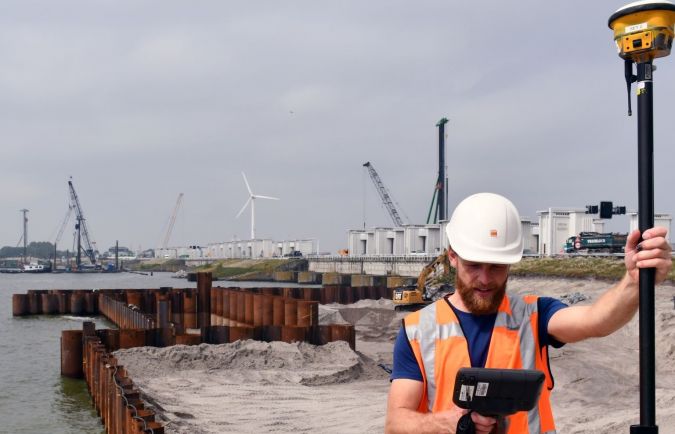

Value staying current with geomatics?
Stay on the map with our expertly curated newsletters.
We provide educational insights, industry updates, and inspiring stories to help you learn, grow, and reach your full potential in your field. Don't miss out - subscribe today and ensure you're always informed, educated, and inspired.
Choose your newsletter(s)
